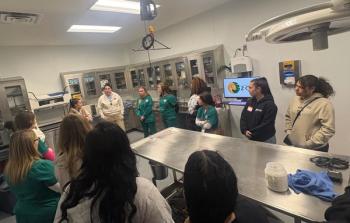
Advanced trends in veterinary dentistry (Proceedings)
The field of veterinary dentistry has changed rapidly in the last few years.
The field of veterinary dentistry has changed rapidly in the last few years. Dentistry in the veterinary clinic is no longer limited to teeth cleanings and extractions. The pet has become a family member, so the client has come to expect more from the veterinarian. It is becoming important that the veterinarian in a general practice be aware of what options are currently available to the client in need of veterinary dentistry. The veterinarian should know what procedures can be done to save fractured or damaged teeth. Extraction may not be the only option.
Fractured teeth
Not all fractured teeth require extraction. If the fracture is not into the pulp canal, an odontoplasty can be done to smooth the fracture site. A sealant or composite restoration could also be applied to the fracture. If the fracture is into the pulp canal, the options are extraction, vital pulpotomy and root canal therapy.
A vital pulpotomy can be done if the fracture is very recent, less than 48 hours. This procedure is to try to keep the tooth alive and vital. A small amount of the pulp is removed and replaced with calcium hydroxide or a product called MTA. This is to hopefully stimulate the vital pulp to lay down a secondary layer of dentin, and keep the tooth alive. The tooth must be closely monitored to be sure that it remains vital. Dental radiographs should be done every 6 months to a year. The pulp canal should get smaller as the vital tooth ages. The apex of the tooth should be monitored to make sure that an abscess in not forming. The client should be advised that a root canal procedure may need to be done in the future.
Root canal therapy
Root canal therapy is done when a tooth has been fractured for a period of time. When a tooth is fractured into the pulp canal, the pulp is contaminated with bacteria. If not addressed very soon, the bacteria contaminate the entire pulp. Often the fracture site will seal with plaque and debris, the bacteria will then multiply and kill the pulp. The multiplication continues and will abscess out the apical delta of the tooth. Often a facial swelling will occur. It may take months to years for this to appear. An apical abscess can often be seen on a dental x-ray much sooner. Antibiotics will reduce this swelling temporarily, but will return when antibiotics are discontinued. The root canal procedure will maintain the integrity of the tooth.
An opening to the pulp canal is made into the crown to provide a straight line access to the apex of the tooth. Using endodontic files in increasing size, the pulp is removed. The canal is flushed with a dilute bleach solution, followed by hydrogen peroxide several times during the filing stage. When the canal is sufficiently cleaned, paper points of the proper size are used to dry the canal. A Zinc Oxide/Eugenol (ZOE) mixture is then applied to the pulp canal. The bulk of the ZOE is the removed. The entire canal is then filled with gutta percha to force the ZOE into the dentinal tubules. This product is a hard rubber like product that when warmed can be and packed into the pulp canal to force the ZOE into the dentinal tubules. It is very important that the apex be totally sealed to ensure that the apical abscess will not return.
Intra-oral radiographs are taken throughout this procedure to make sure the proper filling of the canal and to make sure the apex is sealed. The access opening is then closed with a light-cured composite.
This procedure is radiographed in six months to ensure that the apical abscess is resolved. At this time if the apical abscess is resolved, it may be necessary to have a metal crown made for the tooth. This usually requires two steps. The tooth is prepared for a crown, impressions and models are made in the first step. These impressions and models are then sent to a dental lab to have a metal crown made. The second step is placing the crown onto the tooth with an adhesive designed for this purpose.
There must be enough tooth structure available to support the metal crown. The crown will not be the original length of the tooth; it will cover the remaining tooth. The outside layer of the tooth will be shaved down roughly the width of the crown wall to just above the gingival line. This allows a smooth transition from tooth to gingival margin, not providing a surface for plaque to adhere.
Use of acrylics in veterinary dentistry
The development of strong, non-thermal, fast setting acrylics have found various uses in veterinary dentistry.
Base narrow malocclusions can be a reason to utilize acrylics. When a pet has a base narrow occlusion of the lower canines, the trauma that occurs to the hard palate can be severe. The lower canines can cause holes into the nasal cavity if left unaddressed. The acrylic Maxi-Temp can be formed into an incline plane on the hard palate. An incline is formed over the point where the canine is hitting the hard palate. This will force the canine to move bucally to a comfortable position in the dentition. This usually tolerated very well by the patient and will be completed in 6-8 weeks.
Maxillary fractures can be stabilized by this splinting material. Teeth are held in proper position by wire. A figure eight wire between the upper canines will also provide support the splint. The splint is applied to the hard palate covering the fracture and the wire. The acrylic is smoothed with acrylic burs to lessen irritation. This material can be used on midshaft mandibular fractures. Wires are threaded through the teeth on each side of the fracture and incorporated into the acrylic applied to the long axis of the mandible. These also are usually well tolerated by the patient.
Treatment of enamel hypo-calcification
When puppies are exposed to high fever before eruption of the adult dentition, enamel hypo-calcification/enamel hypoplasia can occur. This appears as pits in the enamel of the teeth. This is exposed dentin and plaque will adhere to this very easily thus staining the teeth. Dentin is porous, so it is possible for bacteria to migrate into the pulp canal. These teeth need to be cleaned and polished very well. After cleaning with ultra-sonic and hand scaling, an air polisher is used to get the remaining staining off the teeth. This polisher attaches to the high speed hand piece hose of the dental unit and sandblasts the teeth with micronized sodium bicarbonate powder and water. This cleans the teeth very well. The next step is to apply a composite surface sealant to the teeth. This is a clear liquid that is painted on the teeth then cured with an ultraviolet curing light. This seals the dentin tubules preventing the plaque from sticking to the teeth thus preventing bacteria from migrating into the pulp cavity and causing the teeth to die. This is repeated every 3-6 months as needed.
Dental radiology and digital imagining
In order to the best quality veterinary dentistry, intra-oral radiology is very essential. Digital radiology is very economical when considering the ease of use and shortened learning curve. A digital sensor is placed in the patient's mouth in place of a film. This sensor is connected to a computer. A standard dental x-ray unit is used to expose the sensor. An image of the teeth appears on the screen in 15 seconds. If the position is not adequate, another view can be taken right then. This eliminates some frustration and saves a lot of times in developing. These images can then be enhanced and manipulated in many ways. It is very easy to print them out for the client, or e-mail them to a specialist for interpretation. This method shortens the tech time involved, freeing them up to be productive elsewhere. The ease of taking radiographs will encourage the veterinarian to take more, thus finding more things that need to be treated, increasing the income of the practice. Most radiographic units will pay for themselves very rapidly.
Barrier sealant
The use of a barrier sealant at time of a dental cleaning has recently become available to veterinary medicine. This product is Oravet sold by Merial. It is sold as a professional pack and a home care kit. The professional application is applied to the teeth after cleaning and polishing. The teeth must be wiped dry before application. The application is in a small plastic cartridge. It is suggested that this cartridge be placed in warm water to be softened. This will allow a much smoother application. Using the provided applicator gun, the appropriate amount of product is applied to the gloved index finger of the applicator. It is then pressed by the thumb. These fingers are the used to wipe the product on each side of the teeth in all four quadrants of the mouth. This technique allows for complete coverage and uses less of the product. This keeps the cost down to the client, resulting in better compliance at home. The home care product is then applied by the client once weekly. The client can warm the product at home and need only apply to the outside of the teeth. The professional application is designed to stick to the teeth; the homecare product is designed to stick to the professional product.
Periodontitis vaccine
A vaccine has been developed to aid in preventing periodontitis by a reduction in bone changes associated with the bacteria Porphyromonas denticanis, P. gulae, and P. salivosa. Microbiological survey identified three black pigmented anaerobic bacteria (BPAB) as the most common pathogens in canine periodontitis. The Porphyromonas vaccine is a liquid preparation of inactivated Porphyromonas bacteria. Systemic antibodies present in the cervicular space and saliva and present in crevicular floe around each tooth. Antibodies to periodontal pathogens may prevent colonization, kill bacteria, and neutralize virulence factors (e.g., proteases). The vaccine has provisional approval. It is given in series of 2 vaccinations three weeks apart. This may prove to be a good addition to the many tools needed to prevent periodontal disease.
Summary
It is essential that the veterinary technician, veterinarian and entire professional staff be aware of all the options available to our patients in order to offer the best quality care available.
Newsletter
From exam room tips to practice management insights, get trusted veterinary news delivered straight to your inbox—subscribe to dvm360.






